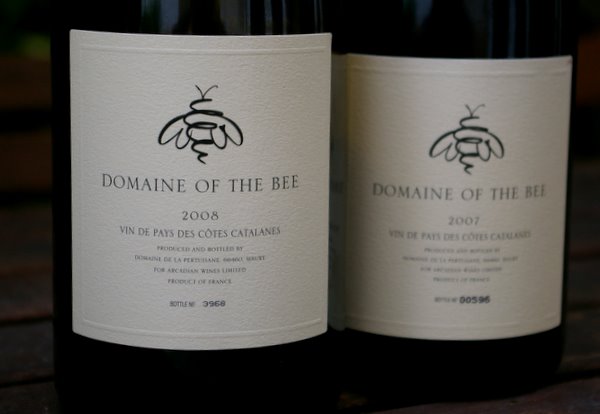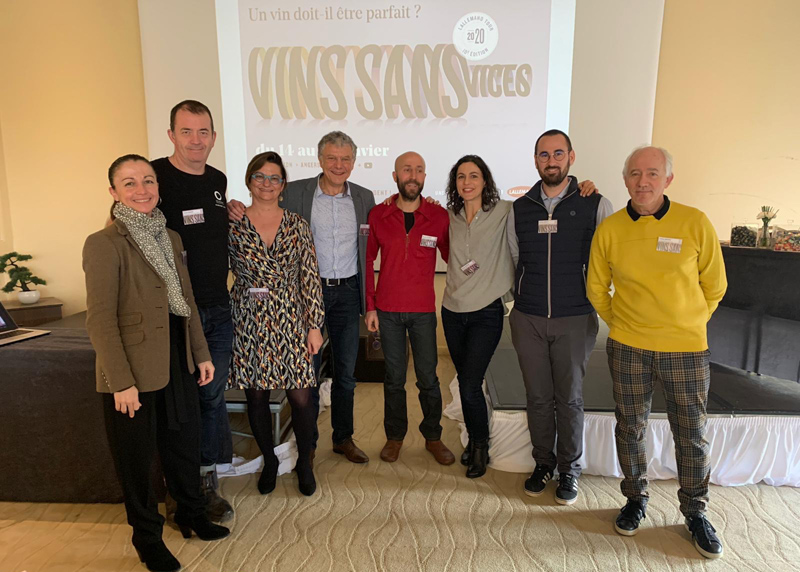A couple of years ago, Justin Howard-Sneyd, who was then in charge of wine at UK supermarket Waitrose, told me he had bought a small vineyard in the Roussillon, as a sort of hobby project. Justin is a competent guy, so I was intrigued – what sort of style would he go for?
Then, a few weeks ago, Justin (who is now in charge of wines at Laithwaites) sent me two wines to try. His venture is called Domaine of the Bee (website here), and it has got to the stage where he has more wine than he and his partners can sell through their network of friends.
At 15% alcohol, these are big wines, made from old vine Grenache and Carignan. I liked the 2008 over the 2007 because it was fresher. They’re both very good, but I wonder whether picking slightly earlier might result in wines with more freshness and definition? But that’s a personal style issue, I suppose, and it seems a bit mean to criticise such impressive early releases.
Domaine of the Bee 2007 Vin de Pays des Cotes Catalanes
15% alcohol. Lush, brooding, sweet dark cherry and plum nose with a stewed plum character. Ripe and slightly baked. Nice savoury twist to the sweet fruit. The palate is lush and broad with liqueur-like richness to the plum and blackberry fruit. There are spicy, leathery, savoury notes, with dry tannic structure. Warm and broad. 89/100
Domaine of the Bee 2008 Vin de Pays des Cotes Catalanes
15% alcohol. Deep coloured. Vivid and powerful with dense blackberry and plum fruit and firm, spicy tannins. Concentrated and sweetly fruited but still fresh. It’s a bit like a dry vintage Port. The alcohol makes its mark, subduing the fruit characters on the nose a bit, but this is still a delicious wine in a modern mould. 91/100
They’re both available from the website, with the 2007 at £18 and the 2008 at £20, with discounts for multi-bottle orders.
11 Comments on Domaine of the Bee: a new high-end Roussillon wine

expensive for entry level wines from the Roussillon.Compare the price of someone who makes the wine of the quality of Dom Treloar for example
Very expensive for VdP. There is a lot of great wine at under £15 or under £10 in the Languedoc Roussillon.
By the standards of the Roussillon (which is not like the Languedoc) these prices are not outlandish. However, I do think these wines are sporting high alcohol even for this region.
Do not see a problem with high alcohol as long as the wine is balanced, although I suppose from a merchants,and owners perspective,it is easier to sell a wine with lower abv in the nanny state we live in.!!!!
I am beginning to find the lumping-together of Languedoc and Roussillon to be unhelpful. Treloar is obviously a star for value as well as quality. Would be interested to know if the Bee guy will be doing any whites. Doug’s a bit of a high-end specialist, I guess, and those wines do seem quite cheap in comparison to many boutique wines from the area, I guess it just depends on how good they really are.
very different Terroir between Treloar and near Maury, where these wines are from. Much lower yields & more mountainous terrain.
from the website…
“Most wine, made from relatively vigorous young vines in reasonably fertile soils with good access to water will produce approximately one bottle for every square metre of vineyard land. A hectare is 100 metres x 100 metres (a bit bigger than a football pitch). So – approximately 10,000 bottles. In an area like, say, Chateauneuf-du-Pape, where the lack of fertility and the absence of easy water give the famously concentrated (and alcoholic) style of one of France’s favourite wines, you might expect 4-5,000 bottles a hectare.
We have 4 hectares, so if we had yields equivalent to Chateauneuf, you might expect 15-20,000 bottles, but we only made 3,000 bottles of this wine in 2007. Imagine a square 4 metres by 4 metres. With one bottle sitting in the middle. That is roughly the yield that these ancient vines give us.
The flipside of this alarmingly small production is that the quality and concentration of the wine produced has the potential to be exceptionally good.”
Jamie, thanks very much for witing up our wine, and thanks to all of your readers for all of the comments – much appreciated.
I can assure you our wine is not expensive because we are making a lot of money! It is simply a product of the tiny yield we have been enjoying, and the relative inefficiency of doing everything on a small scale. I think the value-for-money stands up against £20 Chateauneuf. Having said that, there’s undoubtedly some great value under a tenner in the region.
In response to Alex Lake – no, we are not doing a white – we have a few white vines in amongst the oldest Grenache, but at the moment it all goes in with the red. I doubt we’d have enough even to fill one barrel. Richard Case, who makes our wine, has made some fabulous whites from Maccabeu, Carignan Blanc and Grenache Blanc.
Would you be interested in a breakdown of our production costs? I have been thinking about publishing our business plan, but have not yet had the time to add the pages on to our website. Let me know if you think this would be of value.
I’ve only just read this and the comments. I’d just like to say a couple of things. Firstly, I’ve drunk Justin’s wines on a few occasions and think they are very good and very enjoyable, particularly the 2010. I don’t think they are overpriced. Maybe my wines are underpriced but Justin and I came from different backgrounds, have different business models and are selling our wines in different ways.
To answer Dave Fuller. Yield is not simply about terroir. My wines have an average yield of 25hl/ha. So that’s 3300 bottles per ha. Roughly comparable with Justin’s Maury vineyards.
I don’t think it’s fair to say that any wine is overpriced because you can name a cheaper one from the same region. Especially if you haven’t tasted the wine in question.
Recent convert to this wonderful wine and wherever
I take it as a gift they all love it as I do. Drinking
2007 and 2008 now. Excellent.